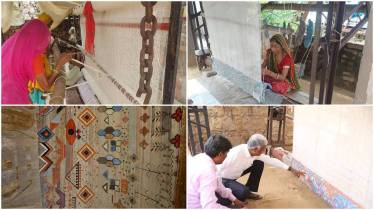People call the founder of Jaipur Rugs Gandhi of the carpet industry. For the women artisans in Jaipur’s villages he is ‘Bhaisaab’ or the elder brother. Forbes India described his work as ‘the Magic Carpet’ once. Nand Kishore Chaudhary of Jaipur Rugs literally weaved a success story worth sharing. Talking to FinancialExpress.com’s Tarun Bhardwaj, NK Chaudhary got nostalgic. “After the graduation, I started my career in a shoe-shop with my father but left it soon. I then gave up a bank job and borrowed Rs 5,000 from my father to start this carpet business. The Journey of Jaipur Rugs started with just 2 looms and 9 weavers and one scooter in Rajasthan in the year 1978.” Over four decades later, he is eying a group revenue of over Rs 1000 crores this year.
Just 40 km north of Jaipur is Manpura village. Another quiet dusty Rajasthan village but when you dig deeper there is a quaint identity to this place. This is where Shanti Devi is leading a group of around 100 women and skilling them in the art of weaving and develop sustainable livelihood for their families. Shanti Devi wasn’t always a leader she is now. As a child bride she was forced to leave education and face the day to day struggles of running a household and not so supportive in-laws. As her husband was unemployed, she learned shouldering responsibility as a young girl. She was a mother soon and didn’t have any means to support her family. It was a life-changing moment for Shanti Devi when she came to know about the work ‘Bhaisaab’ is doing and providing livelihood opportunity at their doorsteps. Weaving rugs is something her Raigar community was doing for centuries, she joined Jaipur Rugs and weaved her own destiny. Shanti devi is now a trainer and incharge of two centres. She is also a Bunker Sakhi and is problem solving face for the entire weaving community of Jaipur Rugs in village Manpura. She started with two looms and today she manages more than 60 looms in her village.
“I got this idea from a foreign friend to start working with the people of the tribal community and treat them like family, love and empathy and after three years they started trusting and believing me as their mentor. I stayed in Gujarat’s tribal region for 8 years and gave job opportunities to 15,000 people. Now we are replicating the same story with Rajasthan’s weaver community,” Chaudhary said with a glee in his eyes.
Also Read | The intangible heritage of India
Today, Jaipur Rugs has 7,000 looms and is working with over 40,000 artisans across the country (out of which 85% are underprivileged women). Under Chaudhary’s leadership Jaipur Rugs has increased its global presence to 70 plus nations, from just two a decade ago. His efforts have been recognized on a global stage with the brand winning several prestigious global awards in the design and carpet industry. Some of these include – Elle Décor Award, Deezen Award, German Design Award, iF Design Award and Carpet Design Award.
Chaudhary didn’t stop at transforming the lives of rural and tribal community only. He gave the taste of freedom to those who are bound, literally. Jaipur Rugs started working with long-term prisoners of Jaipur, Bikaner and Dausa Jails and asked them to design their own rug spontaneously on the loom. What they created without a set pattern was magic and expression of their heart. With it Freedom Manchaha was born. Chaudhary was already working on Manchaha with rural folks giving them chance to weave their creative imagination. Freedom Manchaha took it to the next level. A section of society set-up for failure are transformed through self-expression to heal and spark change in their lives. Each rug in the collection has inspiration from the prisoner’s own lives and is made of 222,184 individual knots in every square meter using hand-spun leftover yarn in carpet production which cannot be used afresh. This reduces industry-wide wastage that had previously no solution. It makes the colour palette as unique as the design. It enables sustainable production – reusing and revival from waste, the problem becoming its own solution.
Also Read | Folk fiesta: Jodhpur’s iconic Mehrangarh Fort is set to buzz again
Chaudhary built Jaipur Rugs by emphasizing family ties and strong personal loyalties. His foundation allows Jaipur Rugs to efficiently operate a highly decentralized manufacturing and logistics system. The five Chaudhary children viz, Asha, Archana, Kavita, Yogesh and Nitesh head different areas of the company. Besides them, many of the area commanders and entrepreneurs who own the businesses that are key parts of the production processes got their start as weavers for NK Chaudhary.
Under their leadership, Jaipur Rugs’ is offering competitive wages in villages to those who work with them. It is investing in skills training and recruiting new weavers for the company.
Weaved by the so-called untouchable community, carpets of Jaipur Rugs have now reached the homes of the who’s who of India. From Prime Minister House to the interiors of Karan Johar, Madhuri Dixit, Virat and Anushka’s homes, Jaipur Rugs is everywhere. Recently Ranveer Singh chose Jaipur carpets for his bold photo-shoot. It is great, said Chaudhary. “We train and skill 1500 – 2000 weavers every year and getting. The whole world is demanding hand weaved products and we are glad that we are specialized, focused and promoting hand made products only. So I believe this industry will be alive for many years,” Chaudhary said with optimism and high hopes for the future.
